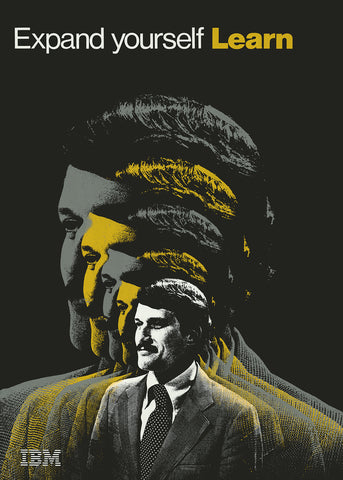Reflections on The IBM Poster Program by Robert Finkel and Shea Tillman
Authors Shea Tillman and Robert Finkel reflect on writing their book, The IBM Poster Program: Visual Memoranda; considering why they were compelled to write it, how they worked together and combined their individual perspectives, and how the project developed out of a gift to Auburn University, into an exhibition and now a book...



Poster Designs: (left) 'Mile High IBM Club Arts and Crafts Exhibit' 1969-79 by Tom Bluhm and (right) 'How to Stuff a Wild Duck' by Ken White 1973.
The story behind the book The IBM Poster Program: Visual Memoranda is fun because it is really about us sharing a gift. It began in 2016, when retired IBM industrial designer John Stram, of Kansas City, Missouri gave Auburn University a collection of industrial and graphic design work from the IBM Design Center at Boulder where he had worked 40 years earlier. Part of this gift included a stack of over 90 posters strikingly designed and produced within the Design Center for the sole purpose of informing and educating IBM’s employees.
Robert teaches graphic design and I teach industrial design at Auburn, yet we both have a common interest in design history, as well as brand identity within visual communications and product development. In overlaying these commonalities, the creative work at IBM during the mid-20th century really stands apart in being beyond excellent both in concept and execution. The first-class expectation of IBM’s business culture in that period meant that these posters were produced with the craft and skill normally required in fine art, despite being bulletin board memos. So, I guess you could say that the opportunity to bring this incredible work back out into the light was something that hooked us right from the start.



Posters: 'Suggest' by Tom Bluhm 1969-79, 'Family Day' by John Anderson 1969-79 and 'Expand Yourself: Learn' by Ken White 1975.
After cataloging and printing thumbnail photos of the posters, we immediately began researching the people behind their creation in order to properly credit them for a potential exhibition. This included visiting two of the people involved in the poster designs: Tom Bluhm (graphic designer) and Rodger Ewy (photographer). Tom and Rodger both warmly welcomed me into their homes, allowed interviews, and provided the much-needed credits and backstories for the posters. Tom also gave us an additional 25 of his posters to add to the collection. We scanned each poster in high-resolution and digitally adjusted the ink and paper colors to replicate the original print as closely as possible. Efforts to maintain these corrections would later be meticulously carried through in the printing of the book.
 Behind the scenes with the authors
Behind the scenes with the authors
While the archival research was being conducted, Robert developed the identity for the Visual Memoranda exhibition and a website gallery to showcase the posters online. He incorporated the recently developed IBM Plex and Neue Hass Grotesque typefaces which create a cohesion between the visual language of the old and new IBM. The College of Architecture, Design and Construction at Auburn University, of which we are a part, also provided grant funding that was instrumental in supporting the initial costs for both an exhibition and book publication. The posters were first exhibited in 2018 at the Jule Collins Museum of Fine Art in Auburn, then in 2019 in New York at the Type Director’s Club and in IBM’s 88U offices in Manhattan. The successes of these exhibitions and subsequent requests for a publication led us to write The IBM Poster Program. Robert did an amazing job expanding the visual identity into a book design that effectively organizes the posters into themes (visual-based) and series (content-based), and the text expands upon the back-stories of the Design Center and the posters themselves.



It is somewhat ironic that while all these posters were created within the most advanced computing company on earth, none were actually designed using a computer. Through the mid-1980’s, most graphic design artwork was conceived and developed on a drafting board employing hand drawings, intricate paste-ups, and film imagery shot on large-format stat cameras. In addition, because IBM originally produced these for internal consumption, few source files were cataloged, and most were never documented or digitized. The relative confidentiality and obscurity of the work meant that even IBM Corporate Archives, based in Poughkeepsie, New York, had virtually no records of them. This project enabled us to collaborate with IBM archivists in order to re-include these restored, digitized posters into their company archive.
Sharing has truly been our core motivator in the researching, writing and designing of our new book, The IBM Poster Program. This project has allowed us to highlight this historic example of design excellence with our students, our colleagues, and IBM’s current employees and archives in the same spirit as the posters were given to us. It is our hope that all those who read the book and reflect on these visual memoranda will better appreciate the work and that it will impact their own pursuit of design excellence no matter the task.
-- Shea Tillman and Robert Finkel, March 2021.
Shea and Robert's book will be out on 12th March. Order your copy HERE.
Keep an eye out for more teaser content on the story of the IBM Poster Program on the Lund Humphries Blog and social media.


